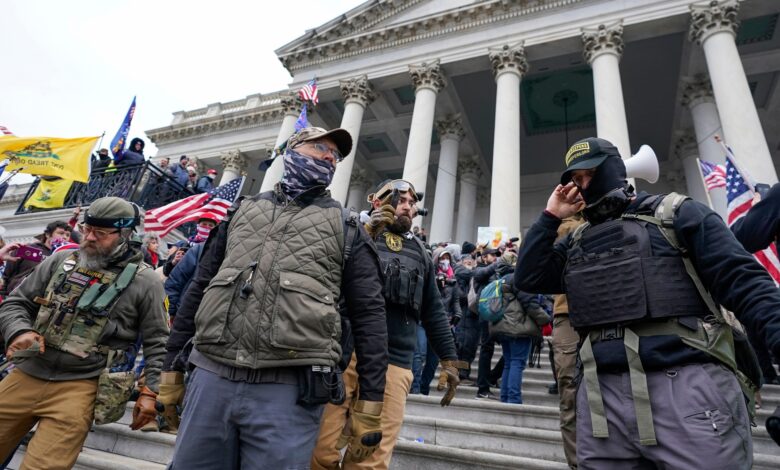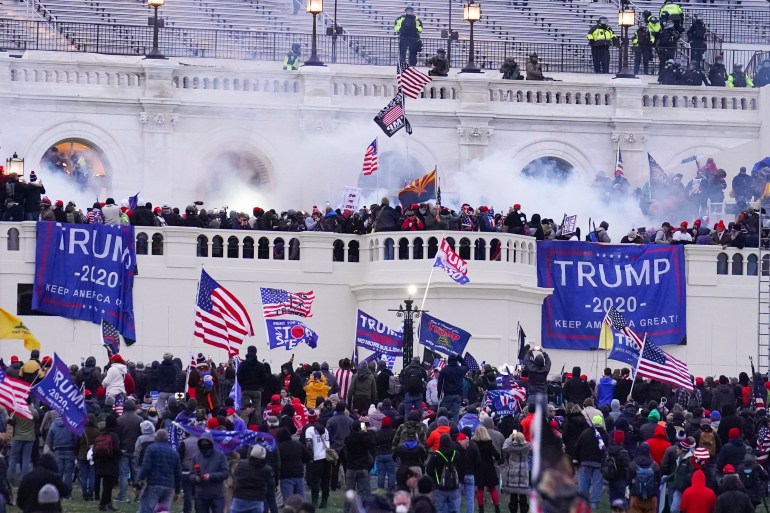Three years on, January 6 Capitol riot reverberates in US courts, 2024 race

Shattered glass. Clashes with police. Angry protesters scaling walls outside the United States Capitol.
The images from the Capitol riot on January 6, 2021, remain some of the most memorable in modern political history. That day saw thousands of supporters of then-President Donald Trump storm the building in an effort to overturn his election defeat, forcing legislators to flee for safety.
But three years on, the country continues to grapple with the ramifications. On Friday, the eve of the riot’s anniversary, current President Joe Biden evoked the violence in a campaign speech near Valley Forge, Pennsylvania, warning of its enduring effects on US democracy.
“Three years ago tomorrow, we saw with our own eyes the violent mob storm the United States Capitol,” he said. “For the first time in our history, insurrectionists had come to stop the peaceful transfer of power in America — the first time.”
Biden also took a jab at Trump, calling him out for inaction on January 6 and election-related lies. “It was among the worst derelictions of duty by a president in American history.”
How the insurrection is viewed remains a bitter point of contention, dividing the US public largely along partisan lines. Trump has maintained that the 2020 election was “stolen” from him, a falsehood that helped fuel the Capitol riot.
This March, Trump faces a federal indictment for his role in trying to overturn the 2020 results. He is currently seeking a second term in the 2024 presidential race, as is Biden, the Democrat who defeated him in 2020.
In addition to Trump’s case, lengthy prison sentences continue to be handed down to participants in the Capitol riot. On Thursday, Christopher Worrell, a member of the far-right Proud Boys group, was sentenced to 10 years in prison for his role in helping to breach the Capitol.
He joined other prominent far-right figures — including ex-Proud Boys leader Enrique Tarrio and Stewart Rhodes, head of the Oath Keepers militia — in facing a decade or more in prison.
On the third anniversary of the Capitol riot, here’s all you need to know about how the insurrection continues to reverberate across the US.

Trump case
In August, the former Republican president was indicted in a federal case brought by Special Counsel Jack Smith, a former prosecutor appointed to investigate his efforts to overturn the 2020 election results.
Trump faces four criminal counts as part of the indictment: conspiracy to defraud the US, conspiracy against rights, conspiracy to obstruct an official proceeding and obstructing an official proceeding.
US prosecutors argued that Trump “attempted to exploit the violence and chaos at the Capitol by calling lawmakers to convince them, based on knowingly false claims of election fraud, to delay the certification” of the election results.
Trump has pleaded not guilty to the charges and denied any wrongdoing. The ex-president has also accused prosecutors of conducting a politically motivated “witch hunt” to derail his 2024 re-election bid.
The federal case is set to begin on March 4, a day before “Super Tuesday”, when more than a dozen states are expected to hold their 2024 election primaries.
Criminal charges
In early December, the Department of Justice released its most recent tally of the criminal charges that resulted from the January 6 riot, noting that more than 1,237 people have been charged.
Of those, more than 700 defendants pleaded guilty to a variety of charges. About 450 have been sentenced to prison.
So far, the most serious riot-related charge has been seditious conspiracy. A relatively rare charge dating to the Civil War era, seditious conspiracy is used to prosecute two or more defendants accused of plotting to overthrow the US government, launch a war against it or hinder its authority, including the execution of its laws.
Seditious conspiracy is notoriously difficult to prosecute. Nevertheless, Rhodes and Tarrio were both convicted of it last year, receiving 18- and 22-year prison terms respectively — the longest sentences to date.
On Thursday, in an address ahead of the January 6 anniversary, US Attorney Matthew Graves described “scenes often reminiscent of a medieval battle”, where police were forced to engage in hand-to-hand combat with rioters armed with “dangerous weapons, including firearms”.
“The siege of the Capitol is likely the largest single-day mass assault of law enforcement officers in our nation’s history,” Graves said. He noted that the 140 reports of physical injury among police officers likely represent an undercount.
Political polarisation
Meanwhile, a notable percentage of Americans continue to believe the false claim that the 2020 election was stolen through widespread voter fraud — an idea spread by Trump and his allies.
Critics say this belief helped motivate the thousands of rioters who attacked the Capitol on January 6.
A recent Washington Post-University of Maryland poll found that 36 percent of respondents still “do not accept Biden’s victory as legitimate”.
Eight in 10 Trump voters and 72 percent of Republicans overall said they believed too much was made of the riot and it is “time to move on”. That contrasts with only 14 percent of Democrats, the poll found.
Respondents were also starkly divided over whether Trump is guilty of conspiracy to defraud the US, the charge accusing him of lying to illegally try to overturn the election.
While 56 percent of Americans overall said they believe Trump is “probably/definitely guilty” of the conspiracy charge, only 18 percent of Republicans agreed, compared with 88 percent of Democrats, the survey said.

Effect on 2024 race
Trump is currently the frontrunner for the Republican nomination in the 2024 race, leading his party rivals by a wide margin. That means he is likely to face Biden again in November, though the four criminal indictments he faces could complicate his campaign.
Meanwhile, the top court in Colorado last month ruled that Trump was ineligible to run for the White House again, citing a section of the US Constitution that bars individuals who “engaged in insurrection” from holding office.
Trump this week asked the US Supreme Court to overturn the decision, which would mean he cannot participate in the state’s Republican primary.
Both Trump and Biden have also referenced January 6 in their 2024 presidential campaigns, albeit to different effect.
Trump has promised to pardon convicted riot participants if reelected, writing last year on social media: “Let the January 6 prisoners go. They were convicted, or are awaiting trial, based on a giant lie.”
For his part, Biden has made defending US democracy a key message of his re-election campaign, saying it was the “central cause” of his presidency. He has framed the January 6 riot as an attack on those democratic ideals.
“Today we’re here to answer the most important of questions: Is democracy still America’s sacred cause?” the Democratic president said at Friday’s speech in Pennsylvania.
“This is not rhetorical, academic or hypothetical. Whether democracy is still America’s sacred cause is the most urgent question of our time, and it’s what the 2024 election is all about.”




